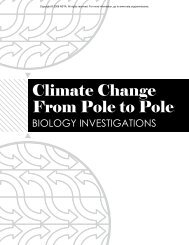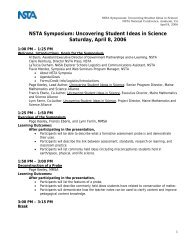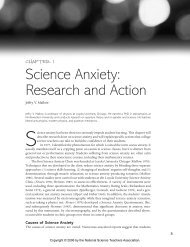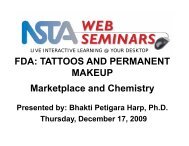Copyright © 2008 NSTA. All rights reserved. For more information ...
Copyright © 2008 NSTA. All rights reserved. For more information ...
Copyright © 2008 NSTA. All rights reserved. For more information ...
Create successful ePaper yourself
Turn your PDF publications into a flip-book with our unique Google optimized e-Paper software.
xiv<br />
Introduction<br />
<strong>Copyright</strong> <strong>©</strong> <strong>2008</strong> <strong>NSTA</strong>. <strong>All</strong> <strong>rights</strong> <strong>reserved</strong>. <strong>For</strong> <strong>more</strong> <strong>information</strong>, go to www.nsta.org/permissions.<br />
Section 2 looks at teaching science through<br />
four lenses . The learner-centered lens focuses on<br />
student engagement and initial knowledge . A<br />
knowledge-centered lens focuses on what content<br />
students should learn and how they should learn<br />
it . An assessment-centered lens focuses on using<br />
assessment to inform instruction and enable<br />
learning instead of just summative assessment .<br />
A community-centered lens focuses on creating an<br />
environment that supports discussion and risk<br />
taking .<br />
Section 3 describes teaching that supports<br />
learning by students from all backgrounds .<br />
Section 4 provides a toolbox of strategies<br />
that are important to good teaching: supporting<br />
literacy, integrating other disciplines, integrating<br />
technology, and teaching preschool and<br />
kindergarten students .<br />
Section 5 describes the content of science<br />
by providing an overview of the content standards<br />
from the National Science Education<br />
Standards .<br />
<strong>For</strong> a matrix showing how the articles used<br />
in this book embody the content standards of<br />
the National Science Education Standards, turn<br />
to p . 341 where the articles are aligned with the<br />
pertinent Standard or Standards .<br />
To kick off this book, I thought it would be appropriate<br />
to include the article “Inquiring Minds<br />
Do Want to Know” by Kaitlyn Hood and Jack<br />
A . Gerlovich . The article describes the experience<br />
of a preservice elementary teacher in an<br />
undergraduate science methods class as she engages<br />
fifth-grade students in scientific discovery.<br />
Hood describes the importance of this approach<br />
when she writes, “Perhaps <strong>more</strong> than anything<br />
else it changed the classroom atmosphere from<br />
presentation to discovery and application . I was<br />
no longer just a performer—I was someone who<br />
knew what the students could do and gave them<br />
a stage on which to perform .”<br />
My hope is that this compilation will help<br />
you to create a classroom that encourages creativity<br />
and promotes exploration, a classroom<br />
that rings with the sound of laughter and a<br />
never-ending stream of questions .<br />
eric Brunsell<br />
Assistant Professor, Science Education<br />
Department of Educational Studies<br />
University of Wisconsin—La Crosse<br />
reference<br />
Pratt, H . 2007 . “Science education’s ‘overlooked<br />
ingredient’: Why the path to global competitiveness<br />
begins in elementary school .” <strong>NSTA</strong><br />
Express. october 29, 2007 . At http://science.nsta.<br />
org/nstaexpress/nstaexpress_2007_10_29.htm .<br />
NATIoNAL SCIENCE TEACHERS ASSoCIATIoN







